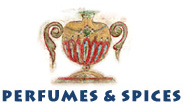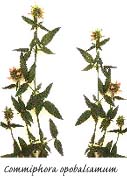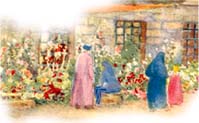|


| Between the Judean desert and the Dead
Sea, at the lowest and one of the most arid spots on earth, is a tropical
oasis with flowing streams and great canyons, beautiful waterfalls and clear
pools. This is Ein-Gedi, famous for its beauty and for the huge, delicious
dates that grow there. In ancient times, however, Ein-Gedi was most famous
for the persimmon — the perfume extracted from the balsam plant. [1] |
The balsam plant is a spice known in biblical
and Talmudic literature by various names. The term afarsemon (persimmon)
which appears frequently in the Talmud and Midrash, designates the perfume extracted
from the resin of the balsam plant (a thorn bush with trifoliate leaves, belonging
to the genus Commiphora opobaalsamum.) When the bark of the lower part
of the balsam trunk was split, the resin which oozed out was soaked up in cotton
wool, and then squeezed into oil which absorbed the pungent odor.[2]
A lthough rarely used any longer as a perfume, the plant is still used in the
Orient as a healing agent for wounds and as an antidote to snakebites and scorpion
stings.
 In
the Bible the plant is referred to as bosem. Although bosem signifies
spices and perfumes of all kinds in the Bible, in the verses from Song of
Songs, “I have gathered my myrrh with my bosem” (5:1) and
“the beds of bosem” (5:13. 6:2), the reference is to balsam
alone. (In modern Hebrew bosem is the word for perfume) In
the Bible the plant is referred to as bosem. Although bosem signifies
spices and perfumes of all kinds in the Bible, in the verses from Song of
Songs, “I have gathered my myrrh with my bosem” (5:1) and
“the beds of bosem” (5:13. 6:2), the reference is to balsam
alone. (In modern Hebrew bosem is the word for perfume)
High praise was lavished on balsam oil
in rabbinic literature as well as by Greek and Roman writers. Natural historian
Pliny relates that in their struggle against the Romans, the Jews tried to uproot
the balsam orchards, to prevent their falling into Roman hands. The Romans,
however, captured them, and Titus, in his triumphal march in Rome, displayed
the balsam branches he had brought from Judea. The orchards in Ein-Gedi (and
Jericho) henceforth provided the Romans with an important source of revenue.[3]
(It is related that Mark
Anthony, wishing to prove his love and
generosity to his mistress Cleopatra, presented her with the orchards of Ein-Gedi
and the Jericho Valley.)
 The
balsam is described in the Talmud as the best and most expensive spice of ancient
times. The Babylonian amora, (scholar) Rav composed a special blessing
for balsam oil: “Blessed art You..... who creates the oil of our land.”[4] The
balsam is described in the Talmud as the best and most expensive spice of ancient
times. The Babylonian amora, (scholar) Rav composed a special blessing
for balsam oil: “Blessed art You..... who creates the oil of our land.”[4]
The Midrash describes its pungent odor as one of the methods used by “sinful
daughters of Zion” to entice lovers: “She would place the balsam between
her heel and her shoe and when she saw a band of young men, she pressed upon
it so that the perfume seeped through them like snake poison.”[5]
The rabbis also taught that in messianic times, the righteous will “bathe
in thirteen rivers of balsam.[6]
One can still observe remains of the terraces in the hills
of Ein-Gedi, where balsam trees once grew, and visit excavations of a workshop
complete with its ovens and vessels. Strains of the balsam tree may still be
found today in Saudi Arabia, Yemen and Somalia.
|
[1]
The most ancient remnants discovered in Ein-Gedi date back to 4000 BCE.
At that time, a temple was built there on top of a cliff facing the Dead
Sea, far away from any known settlement. The Hasmonean kings developed
Ein-Gedi
extensively, turning it into a central city and the king’s home. After
the Romans squashed the Jewish rebellion, the settlement was rebuilt and
once again thrived. In the Byzantine period the Jews who resided there
built a grand synagogue which operated between the fourth and sixth centuries
CE. During the Roman-Byzantine period Ein-Gedi was described as a very
large Jewish village, famous for its fine dates and rare spices. [back]
[2] The German botanist Schweinfurth conducted
investigations in the Arabian Peninsula, where he succeeded in reconstructing
the process of balsam production. [back]
[3] Historia Naturalis 12:25. [back]
[4] BT Berakhot 43a. [back]
[5] Lam. R. 4:18. [back]
[6] JT, Av. Ar. 3:1, 42c). [back]
|
|